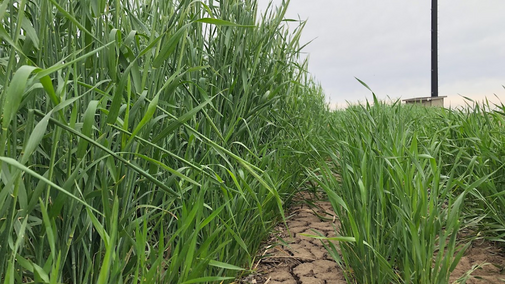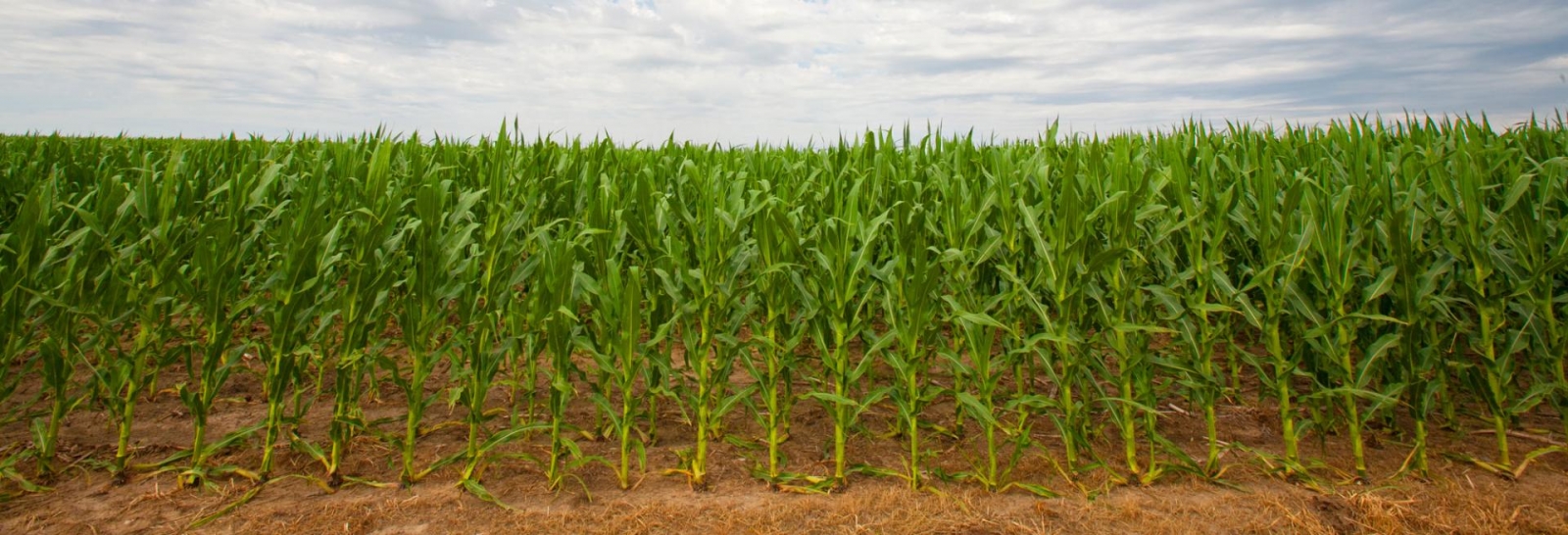Key Takeaways
Rye excels in growth and hardiness. Cereal rye consistently showed the best winter survival and highest spring biomass across all three years.
Wheat and triticale maintain quality longer. Both produced less biomass but retained forage quality later into spring.
Spring growth is fast. All cover crops grew rapidly in mid-April to early May, underscoring the need for timely management and termination.
Choose based on your goals. Variety selection should fit your operation’s needs — whether for grazing, soil cover or ease of spring management.
Thinking about planting a fall cover crop and not sure what to choose? You have options!
Winter-hardy small grains, such as cereal rye, winter wheat and triticale (a hybrid of rye and wheat) are best suited as cover crops for eastern Nebraska. Cereal rye is the most winter-hardy small grain and will generally produce more biomass than winter wheat or triticale, making it the cover crop of choice for most Midwest farmers. On the other hand, winter wheat's shorter stature can make it more manageable than cereal rye, which easily grows to 5 feet tall by mid-May.
Other considerations are whether there is wheat in the rotation, which often precludes the growing of cereal rye or triticale. Wheat and triticale may mature later than cereal rye, and if grazing is intended for the cover crop, growing wheat or triticale can extend the grazing season. Seed costs per pound are lowest for cereal rye, which is selling at an average of $0.27/lb this fall, compared to $0.33 for winter wheat and $0.34 for triticale.
In trials at the Eastern Nebraska Research, Extension and Education Center, we planted small grain cover crops in late September and terminated in early May, comparing cereal rye, triticale and winter wheat in terms of biomass production and forage quality. Trials were repeated for three years. Cover crop varieties and management are described in detail in Table 1 at the end of this article.
What Did We Find and What Does This Mean for Producers?
Two things stand out:
- Rye produced the most biomass in each year, up to 6,800 lb/ac of dry matter.
- Spring growth is rapid, adding up to 1,000 lb/acre of biomass per week in late April to early May.
- Wheat and triticale had more winter-kill than rye.
Let’s look at the data in more depth.
In 2022, rye produced significantly more biomass than wheat or triticale — almost 7,000 lb/ac (in dry matter) by May 9 (see Figure 1). Wheat had almost 5,000 lb/ac and triticale 4,000 lb/ac. Rye was much taller at almost 30 inches and was heading by May 9, whereas wheat and triticale were around 19 inches with the flag leaf just emerging (see Figure 2).
Cover crops had high forage quality, with over 75% total digestible nutrients (TDN) and over 20% crude protein when first sampled in April 2022 (see Table 2). Crude protein and TDN decreased quickly in rye, which had only 63% TDN and 17% crude protein at the last sampling time on May 9; however, triticale and wheat retained forage quality better.
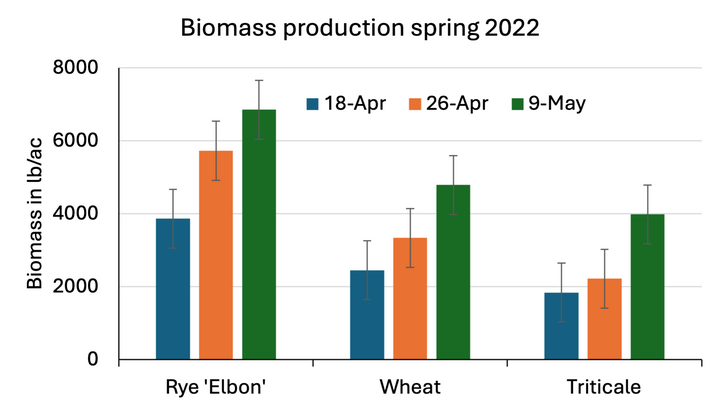
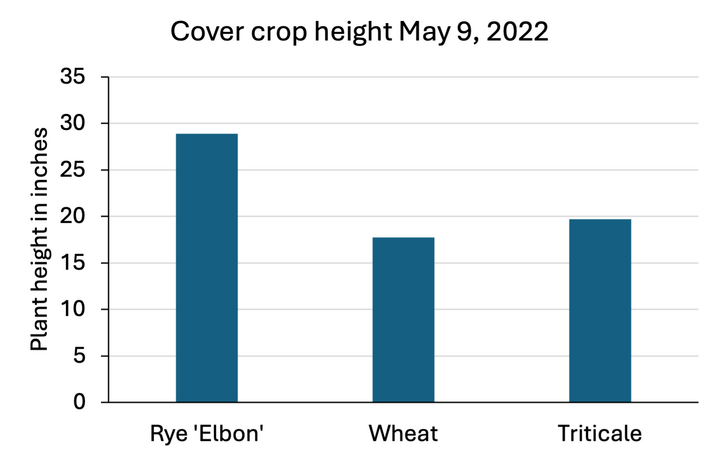
Forage quality at spring sampling dates | |||
|---|---|---|---|
April 18 | April 26 | May 9 | |
| Cover crop | Total digestible nutrients (TDN) in % | ||
| Rye | 79 | 74 | 63 |
| Wheat | 78 | 76 | 70 |
| Triticale | 77 | 79 | 71 |
Crude protein in % | |||
| Rye | 22 | 22 | 17 |
| Wheat | 21 | 21 | 20 |
| Triticale | 21 | 22 | 21 |
In the fall of 2022, cereal rye varieties ‘Elbon’ and ‘Hazlet’ were planted, as well as winter wheat and triticale. Biomass was measured two months after planting and all cover crops had established well, producing about 400 lb/ac of dry matter.
However, by April 2023, clear differences could be observed in how well cover crops were able to survive the dry, snowless winter and spring of 2022-2023. Triticale had completely winter-killed, and wheat stands were poor. The two cereal rye varieties produced similar amounts of biomass, increasing from about 900 lb/ac at the first sampling to 4,500 lb/ac a month later. What a difference one month can make!

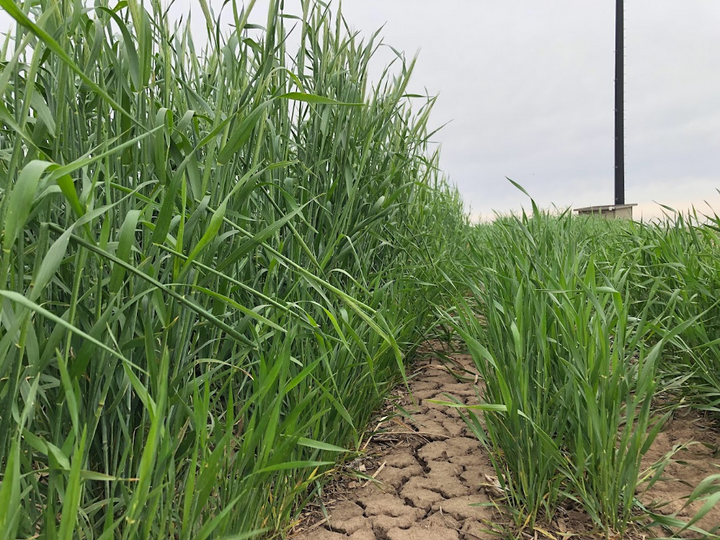
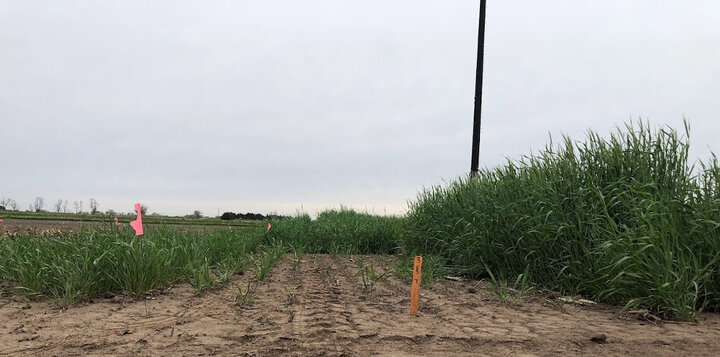
In the fall of 2023, the same small grains were planted again, we added black oats, which are sometimes included in cool-season mixes and promoted as a more winter-hardy oat species. However, it winter-killed completely with no growth observed by spring.
Fall biomass was not collected, and spring biomass was only collected on two dates in the spring of 2024. On April 19, ‘Elbon’ rye had 1,600 lb/ac of biomass, much more than the other varieties which averaged 500 lb/ac. Two weeks later, cover crops had more than tripled their biomass, with ‘Elbon’ reaching 4,900 lb/ac and the other varieties averaging 1,900 lb/ac.
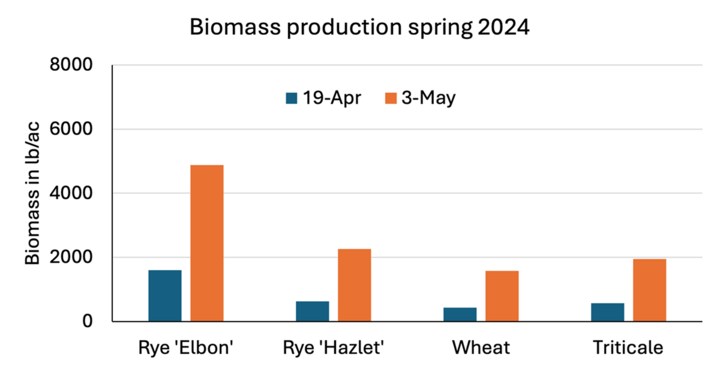
Summary
Our three small grain cover crops differed in winter hardiness, biomass production and forage quality.
- True to expectations, cereal rye had the greatest winter survival and biomass production, especially the variety ‘Elbon’.
- Wheat and triticale had more moderate biomass production, but retained forage quality better than cereal rye, which may be an advantage in some situations.
- All small grains grew rapidly in the spring, a reminder to check on them often and be sure to terminate at a time and size that fits your goals for your cover crops.
Management | |||
| Activity | 2021 – 2022 | 2022 - 2023 | 2023 – 20, 24 |
| Tillage | Pre-plant disking | Pre-plant disking | Pre-plant disking |
| Planting | Drilled Sept. 27, 2021, 7.5” row spacing | Drilled Sept. 26, 2022, 7.5” row spacing | Drilled Oct. 18, 2023, 7.5” row spacing |
| Target seeds/sq ft | 30 seeds per sq/foot | 30 seeds per sq/foot | 30 seeds per sq/foot |
| Cover crop varieties and pure live seed in lb/acre | Cereal rye ‘Elbon’ at 61 lb/acre | Cereal rye ‘Elbon’ at 61 lb/acre | Cereal rye ‘Elbon’ at 61 lb/acre |
| Winter triticale ‘FX 1001’ at 83 lb/acre | Cereal rye ‘Yankee’ at 61 lb/acre | Cereal rye ‘Yankee’ at 61 lb/acre | |
| Winter wheat ‘Gore’ at 92 lb/acre | Winter triticale ‘FX 1001’ at 83 lb/acre | Winter triticale ‘FX 1001’ at 83 lb/acre | |
| - | Winter wheat ‘Gore’ at 92 lb/acre | Winter wheat ‘Gore’ at 92 lb/acre | |
| - | - | Black oats at 68 lb/acre | |
| Biomass sampling | April 18, April 26, May 9, 2022 | Nov. 28, 2022; April 7, April 26, May 8, 2023 | April 19, May 3, 2024 |
* Biomass sampling (clipped biomass in in 2 x 1 feet frame, dried and weighed dry biomass).
